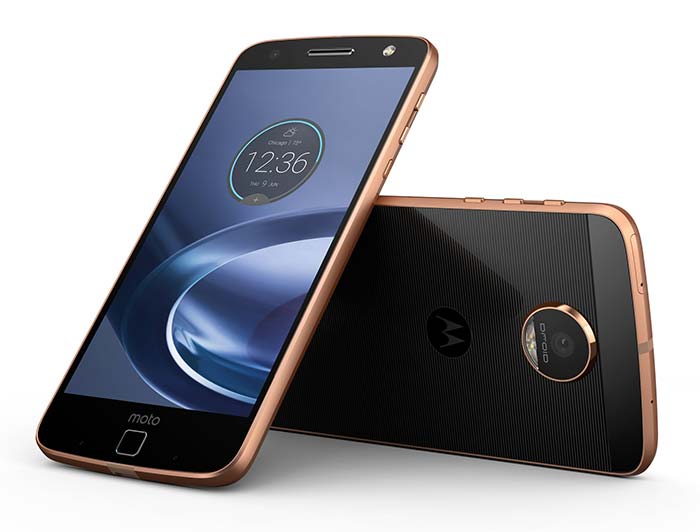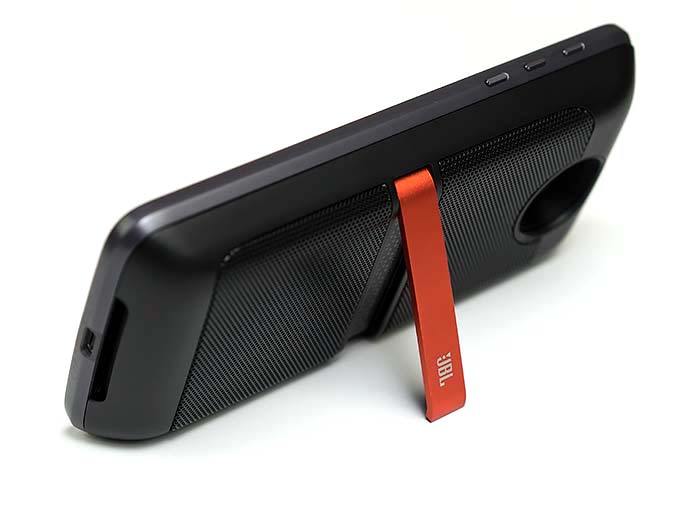|
The Moto Z and Z Force are the first phones to break from Moto's attractive, but well-worn look and feel. Gone are the complexly curved sides, thick middle body and unibody construction. Instead we have a modern and somewhat angular design that's actually very slim, unlike the old Moto design that got chubby toward the middle. Whether this is Lenovo's influence or just the next step for the folks at Motorola who work largely independently from their parent company, we don't know. What we do know is that the Moto Z and Moto Z Force (both Droid Editions in the US and exclusive to Verizon Wireless) are some of the best phones on the market today. They run on the top dog Qualcomm Snapdragon 820 CPU with Adreno 530 graphics and 4 gigs of RAM. They have colorful and very bright QHD 2560 x 1440 AMOLED displays, capable cameras, and a unique modular accessory system that puts LG's "Friends" for the LG G5 to shame. You can get stylish back covers, an extended battery back, a projector (Lenovo does love putting projectors on mobile devices) and a JBL speaker back. It's easy--magnets hold the various back covers firmly on the back, and the phone automatically recognizes them (and informs you of that fact) without a need to disassemble, reboot or yank out the battery. In fact, for better or worse, both Moto Z models' batteries are sealed inside. This is how a modular phone should be: simple and attractive. The question is, do you want or need a modular phone? While I personally don't feel that I must have one, the Moto modules are useful enough and easy enough to use that I find them tempting.
The Moto Z and Moto Z Force are available for pre-order on July 21, 2016 and will be in Verizon Wireless stores on July 28th.
What's the Difference Between the Moto Z and Moto Z Force?
The two models are nearly identical, with the same CPU/RAM/storage, wireless features, screen size and front camera. The Moto Z has a 13MP rear camera while the Moto Z Force has a 21MP rear camera. The Moto Z has a 2600 mAh battery while the thicker and heavier Moto Z Force has a capacious 3500 mAh battery. To be fair, the Moto Z is one of the thinnest phones on the market at 5.2mm, so the 7mm Moto Z Force is by no means thick just because it's not as slim at the Moto Z. Both models' displays are covered by Gorilla Glass 3, but the Z Force has a shatter-proof covering for those who need serious screen robustness. Moto invited us to drop the phone from 5 feet onto a hard floor to test that shatterproof screen, so they're confident (note that this isn't a rugged phone and it might suffer damage elsewhere when harshly tested). $96 sets the two models apart in the US. The Moto Z is $624 ($26/month) on Verizon Wireless, and the Droid Z Force is $720 ($30/month).

Design and Ergonomics
Both phones have slim designs with an aluminum chassis, metal surround and a striped glass back with antenna windows in black at the top and bottom. The phones will likely also be available in white with a gold back and black with gold trim, but our two review units are black with gunmetal trim. The smartphones are intended to be used with Moto Style Shell back covers that cover and protect the many gold pogo pin connectors that interface with optional Moto Mods. With a Style Shell mounted, there's no camera hump, but if you use the phone naked there is a large round camera hump on the back. The shells are slim and light though sturdy, and one is included in the box.
The Moto 5.2mm Z is exquisitely thin (Moto claims it's the thinnest phone currently on the market), and the Moto Z Force is thicker, but still relatively slim for a phone with a 5.5" display. The phones have a fairly large and identical footprint, but they're smaller than the Nexus 6P and 5.5" iPhone 6s Plus. They're easy enough to handle, and the sides are easy to grip, unlike the Samsung Galaxy S7 edge with a curved 5.5" display. That Samsung is however the smallest among the 5.5" competition. Build quality is excellent and the phones feel like quality products, though the front faces are a bit generic and look much like the Moto G4 Plus. The Moto Z models have a front mounted fingerprint scanner that works impeccably. You might be tempted to use that scanner button as the home button, but the home, back and multi-tasking buttons are on-screen. The fingerprint scanner simply locks and unlocks the phone.
The volume buttons and power button are small (perhaps too small) and are clustered tightly together near the top right side of the phone. I'd like more separation or a different size/tactile feel for the power button.
Moto Mods
- Style Covers ($20-$25): these are cosmetic backs and they'll be available in six designs at launch; Washed Oak, Charcoal Ash, Silver Oak, Black Leather, Black Herringbone and Red Nylon. More will be added in the future. They're sturdy, yet slim. Though they slightly thicken the phones, they do remove the camera hump and protect the many data pins on the back. I do like the look of the naked phones, but our black models show so many fingerprints so quickly, that I'd rather cover it.
- The InstaShare Projector ($299.99) has a built-in stand and a secondary 1100 mAh battery. This is a 50 lumen DLP projector (400:1 contrast ratio) that can project up to 70" images and it has keystone and brightness adjustments. For those unfamiliar with projector specs, this isn't a very bright or high contrast projector, so you'll use it in dark rooms to maximize viewability and contrast.
- The JBL SoundBoost ($79.99) makes the phone as loud and full sounding as a laptop...a laptop with better than average audio. The Mod has stereo 3 watt speakers (6 watts total) with a claimed 80db loudness. It also has a 1000 mAh secondary battery and a built-in kickstand.

- Incipio OffGrid power back. A not too thick 2200 mAh battery that augments battery life. It's likely most appealing to those who go with the Moto Z rather than Z Force, since the basic Z has the smaller battery. There are other battery backs coming with some serious style from Kate Spade and Tumi priced from $60 to $90.
There are more Moto Mods under development, and third parties can develop Mods with the help of Moto's dev kit. Mods must be certified by Motorola, which is likely a good thing so you won't have to worry about poorly designed Mods that might disrupt the phone's functions. Motorola says that the Moto Mods platform will be supported by future Moto Z phones, so they'll likely find new life if you upgrade to next year's Z phone.
|
Deals and Shopping:
Advertisement
|

